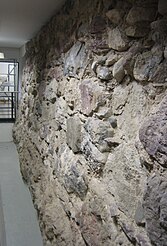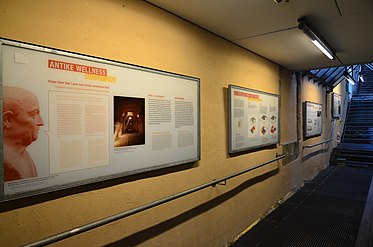Archaeological windows in Zurich
The Archaeological Windows in Zurich are places in Zurich's old town where historical findings are made publicly accessible to the general public, usually at the place where they were found.
Overview
Several archaeological windows are spread across Zurich's old town . In Zurich, archaeological windows are also referred to in a broader sense as showcases and display boards within publicly accessible buildings in which archaeological finds made on site are displayed or described.
The spectrum of these archaeological window ranging from cases with Neolithic finds over ruins of a Roman fort and murals in a former Jewish house from the Middle Ages up to one originally serving for waste and wastewater Ehgraben .
The archaeological windows in Zurich together form a kind of decentralized city museum and have been a member of the Zurich Museums Association since 2013. On many archaeological windows there are text and picture boards with further information. Most of the archaeological windows can be viewed, they are either freely accessible or a key can be obtained from the city archives. The archaeological windows are also part of regular city tours .
The individual windows
Right (east) the Limmat
(from north to south):
- Remains of the city wall from the 13th century and the first aqueduct can be seen in the basement of the Zurich Central Library at Chorgasse 22 ( Lage ) .
- In the “Zum Brunnenhof” house at Brunngasse 8 ( Lage ), late Gothic wall paintings from around 1330 with Hebrew inscriptions were uncovered on the first floor.
- The house "Zum Rech" at Neumarkt 4 ( Lage ), an early modern town house with Romanesque origins, houses the building history archive and the city archive and shows temporary exhibitions on Zurich's city and building history as well as a historical city model of Zurich around 1800.
- In the crypt of the Wasserkirche at Limmatquai 31 ( Lage ) are the martyr's stone, which is considered the execution stone of the city patrons Felix and Regula , burial sites and remains of the church's predecessor buildings.
- The Ehgraben between the row of houses on Kirchgasse and the row of houses on Rössligasse ( Lage ) is accessible either between the houses at Schifflände 30 and 32 or between the houses at Oberdorfstrasse 25 and 27. Information boards with texts and pictures tell the story of sewage and waste disposal explained in the old town.
- In the Opéra car park at Utoquai 21 ( Lage ), showcases show exhibits from the pile dwelling period .
- In the foyer of the Swiss National Bank building at Seefeldstrasse 8 ( Lage ), a selection of archaeological finds is displayed in a showcase that was recovered during an excavation during a renovation of the building in 2011, including fragments of ceramic vessels, stone and bone tools Pendant made of antlers and animal bones.
- In the underwater archeology and dendrochronology department at Seefeldstrasse 317 ( Lage ), archaeological finds, a model of an underwater excavation as well as current information and images are on display in three showcases.
- Select archaeological window on the right of the Limmat
Left (west) the Limmat
(from north to south):
- In the Urania car park in Uraniastrasse 3 ( Lage ), display boards show the history of the place from the Roman temple via the Oetenbach monastery to the cantonal penal institution.
- In the Lindenhof cellar in front of Lindenhof 4 ( location ), the remains of the walls of the Roman fort and the medieval royal palace have been exposed.
- In the Thermengasse near Weinplatz ( Lage ), the ruins of the Roman thermal baths that were uncovered in 1983/84 can be walked on and viewed through a grille on the floor.
- Early medieval graves and remains of the original parish church can be found under the choir of St. Peter's Church in St. Peterhofstatt 1 ( Lage ).
- In the crypt of the Fraumünster at Münsterhof 2 ( Lage ), which opened in 2016 , the archaeological excavations that document the building history of the former monastery church were made accessible to the public. The history of the monastery and its construction phases is shown on information boards.
- Select archaeological window on the left of the Limmat
literature
- City of Zurich, Office for Urban Development (Ed.): Archaeological Windows: Zurich Old Town . Zurich July 2018 ( stadt-zuerich.ch [PDF; 5.0 MB ]).
Web links
- Archaeological windows on the website of the City of Zurich
Individual evidence
- ↑ a b Archaeological Windows. In: stadt-zuerich.ch. City of Zurich, accessed on April 6, 2019 .
- ↑ Archaeological windows in the old town. In: stadt-zuerich.ch. City of Zurich, accessed on April 6, 2019 .
- ↑ City wall cellar . In: stadt-zuerich.ch. City of Zurich, accessed on April 6, 2019 .
- ↑ Brunngasse 8. In: stadt-zuerich.ch. City of Zurich, accessed on April 6, 2019 .
- ↑ Haus zum Rech. In: stadt-zuerich.ch. City of Zurich, accessed on April 6, 2019 .
- ↑ Wasserkirche crypt. In: stadt-zuerich.ch. City of Zurich, accessed on April 6, 2019 .
- ↑ Ehgraben. In: stadt-zuerich.ch. City of Zurich, accessed on April 6, 2019 .
- ^ Opéra car park. In: stadt-zuerich.ch. City of Zurich, accessed on April 6, 2019 .
- ^ Swiss National Bank office building. In: stadt-zuerich.ch. City of Zurich, accessed on April 6, 2019 .
- ^ Department of Underwater Archeology and Dendrochronology. In: stadt-zuerich.ch. City of Zurich, accessed on April 6, 2019 .
- ↑ Urania car park. In: stadt-zuerich.ch. City of Zurich, accessed on April 6, 2019 .
- ↑ Lindenhof cellar. In: stadt-zuerich.ch. City of Zurich, accessed on April 6, 2019 .
- ↑ Thermengasse. In: stadt-zuerich.ch. City of Zurich, accessed on April 6, 2019 .
- ^ City of Zurich, Office for Urban Development (ed.): Archaeological Windows: Zurich Old Town . Zurich July 2018, p. 2 ( stadt-zuerich.ch [PDF; 5.0 MB ]).
- ↑ Fraumünster crypt. In: stadt-zuerich.ch. City of Zurich, accessed on April 6, 2019 .








